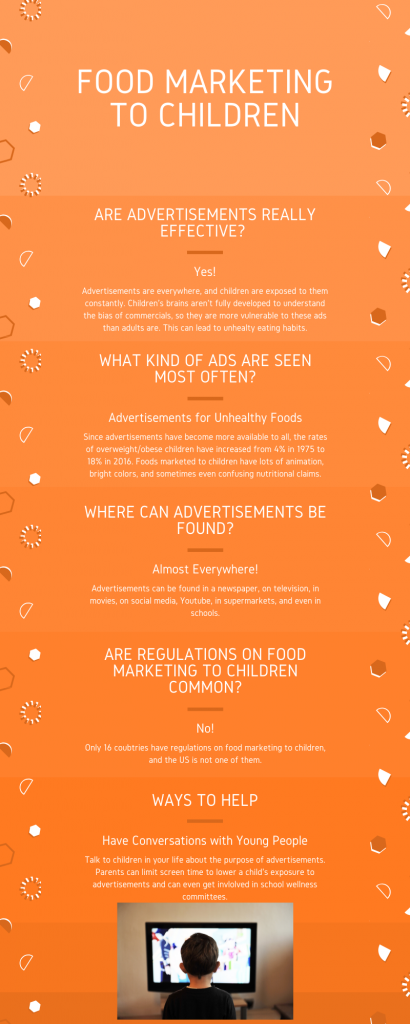20 Food Marketing to Children
Nicole Barber

Advertisements effectiveness
Advertisements are everywhere. They can be seen on billboards on the way to work or school, in commercials while watching the morning news, in a newspaper or magazine, or even on social media. Many of the ads that are seen on a daily basis have to do with food, and nobody can really escape them. In 2014, the food marketing industry spent about 15 billion dollars on food, beverage, and restaurant marketing in the United States alone. This is more than the National Institute of Health spent on research on heart disease, obesity, high blood pressure, type 2 diabetes, and prevention research combined (LoDolce, 2015). Children need to be educated to make the healthy choice despite the fun and colorful advertisements so that they can grow up to be healthy adults.
Children are constantly exposed to advertisements just as adults are. Children come in contact with many ads in many different ways every day. Advertisers market good-tasting, high calorie, inexpensive foods to children through television, movies, the internet, games, at supermarkets, and even at schools (Smith et al., 2019). Children are more vulnerable to these advertisements than adults. Young children are extremely likely to believe ads are factual because their brains are not fully developed (Smith et al., 2019). These children cannot tell that there is bias in food commercials because the marketers’ main goal is to sell their product.
Location, location, location
Advertisements for unhealthy foods are everywhere, and marketers are spending lots of money on them because these advertisements are effective. Since advertising has become more popular and widely available, the rates of overweight/obese children have gone up from 4% in 1975 to 18% in 2016. This is an extremely large increase, and it could affect the health of these children as they grow because children who are obese are very likely to be obese in adulthood as well (Smith et al., 2019).

Foods marketed to children have lots of animation, bright colors, characters, and sometimes even confusing nutritional claims. A study was done in which researchers studied nutritional claims on food packaging compared to what was really in these foods (García et al., 2019). Many countries, including the United States, recommend that people eat five servings of fruits and vegetables daily. Multiple food packages marketed towards children claimed that their food met this goal, while in reality, 75.4% of these foods had less than five servings of fruits or vegetables in them (García et al., 2019). This is a problem because many people don’t realize that advertisers can put confusing claims on food packages. It is important to look at the nutrition label on the back of the package to see what the food is truly made of and not just trust the colorful words on the front of the package.
Common platforms
In the past few years, as technology has become more advanced and more accessible, children have become more used to watching online video platforms such as YouTube as well as being on social media. A study looked at the most popular YouTube videos for children and what advertisements were shown before and during these videos. It showed that 71.38% of these ads were for food and beverages. A surprising 56.3% were for noncore foods which are foods that are eaten for fun more than for nutritional value (Tan et al., 2018). Similar to television commercials, these foods were marketed to children through good taste, how fun they seemed, the newness of the product, price, and confusing nutrition benefits (Tan et al., 2018). In another study, children were assigned to two groups. One group showed children fake Instagram profiles of YouTube stars with healthy food, while the other group saw Instagram profiles with stars and unhealthy food. The group who saw the unhealthy food ate much more unhealthy food, while the group that saw the healthy food did not increase how much healthy food that they were eating (Coates et al., 2019). This shows that countering the unhealthy food ads with healthy ones might not be the best solution.
Food marketing regulations
Only 16 countries have regulations on food marketing to children, and the United States is not one of them (Taillie et al., 2019). Some countries do have restrictions on ads during certain hours of the day while children’s programming is on, and in some places, there are even restrictions in schools. Some countries only restrict unhealthy ads where celebrities are enjoying unhealthy food because children will want to imitate them. However, regulations on television, in movies, and on the internet basically don’t exist anywhere (Taillie et al., 2019). So even though some places have regulations for television and in schools, children will still be exposed to many unhealthy food advertisements that can influence them to eat unhealthy foods.
Prevention strategies
Oftentimes, the fact that food marketing is everywhere makes people believe that children will always be exposed to it and that nothing can be done to prevent it, but that is not the case. It is important for parents, grandparents, siblings, cousins, and others to start the conversation with children about how ads are created to accomplish a purpose (LoDolce, 2015). Eating a cheeseburger will not bring them as much enjoyment as it did for the actor on television. It can also be helpful for parents and guardians to remove screens from their children’s bedroom because it has been found that this condition increases a child’s risk for obesity by 31% (LoDolce, 2015). It is also important for parents to find out how much food marketing occurs at their child’s school. Research shows that 70% of elementary and middle school students see some type of unhealthy food advertising at school (LoDolce, 2015). There are ways to make a difference in schools. All schools are required to have a wellness policy, and parents can become a part of a wellness committee to brainstorm ideas to promote healthy eating. If consumers join public health officials and advocates, they can make a big difference.
Everyone has the power to choose where and how they spend their money. If consumers choose not to purchase unhealthy foods, food marketers will have to change what they are doing and possibly even shift to healthier foods. To start lowering child obesity rates, try to buy less of the unhealthy, eye-grabbing packaged foods with confusing nutritional claims, and try to read the ingredients lists and educate young children to do the same.
For more information, please visit the following links:
https://www.youtube.com/watch?v=0bop3D7-dDM
https://www.youtube.com/watch?v=oxlmrcr-2Bo
Summary
Advertisements are found everywhere, and they are extremely effective. Children see advertisements on television, on the internet, and even at school. Regulations on these advertisements are not common, and only 16 countries have them. Having conversations with young people about advertisements, getting involved in wellness committees at schools, and limiting children’s screen time is the best way to help children make better choices about what they eat now and into adulthood. The following infographic summarizes all of these key points.

Review Questions
References
Cancer Research UK. (2018, October 17). Childhood obesity: do junk food adverts really influence children? [Video]. Youtube. https://www.youtube.com/watch?v=oxlmrcr-2Bo
Coates, A. E., Hardman, C. A., Halford, J. C. G., Christiansen, P., & Boyland, E. J. (2019). Social media influencer marketing and children’s food intake: A randomized trial. Pediatrics, 143(4), 1–9. https://doi-org.libproxy.clemson.edu/10.1542/peds.2018-2554
García, A. L., Morillo-Santander, G., Parrett, A., & Mutoro, A. N. (2019). Confused health and nutrition claims in food marketing to children could adversely affect food choice and increase risk of obesity. Archives Of Disease In Childhood, 104(6), 541–546. https://doi-org.libproxy.clemson.edu/10.1136/archdischild-2018-315870
Lappe, A. [TEDx Talks]. (2013, March 11). Marketing food to children [Video]. Youtube. https://www.youtube.com/watch?v=0bop3D7-dDM
LoDolce, M. (2015). Food marketing to children: A wolf in sheep’s clothing? https://www.obesityaction.org/community/article-library/food-marketing-to-children-a-wolf-in-sheeps-clothing/
Smith, R., Kelly, B., Yeatman, H., & Boyland, E. (2019). Food marketing influences children’s attitudes, preferences and consumption: A systematic critical review. Nutrients, 11(4), 875. https://doi.org/10.3390/nu11040875
Taillie, L. S., Busey, E., Stoltze, F. M., & Carpentier, F. R. D. (2019). Governmental policies to reduce unhealthy food marketing to children. Nutrition Reviews, 77(11), 787–816. https://doi-org.libproxy.clemson.edu/10.1093/nutrit/nuz021
Tan, L., Ng, S. H., Omar, A., & Karupaiah, T. (2018). What’s on youtube? A case study on food and beverage advertising in videos targeted at children on social media. Childhood Obesity (Print), 14(5), 280–290. https://doi-org.libproxy.clemson.edu/10.1089/chi.2018.0037

